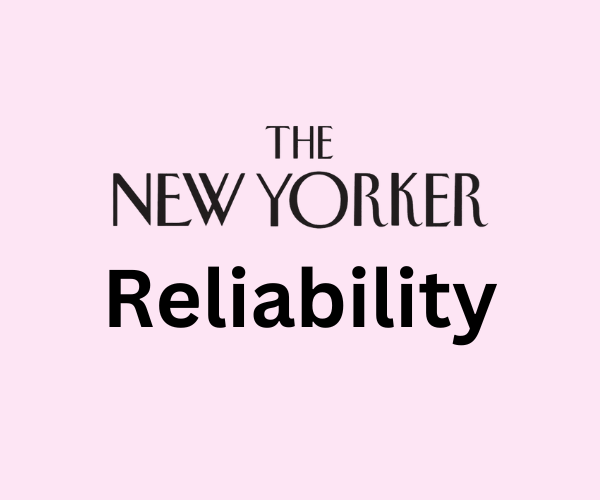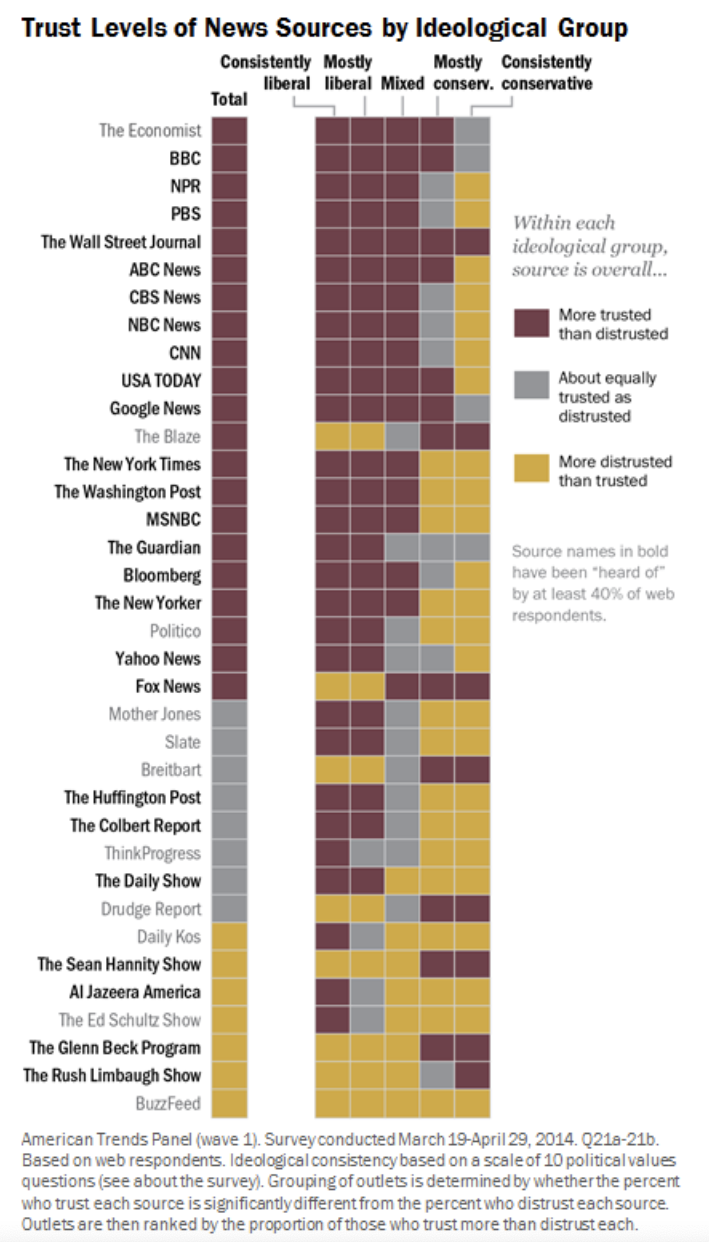
The almost 100-year-old magazine has been renowned for its trustworthiness and credibility. With that in mind, how do contemporary audiences view the source? A study by the Pew Research Center, conducted in 2014, found that The New Yorker is more trusted than distrusted among liberal individuals. Those who hold mostly, or consistently, conservative values placed less trust in the organization. This can be accredited to The New Yorker’s reputation of having a liberal tilt in its reporting, which is supported by Biasly. We will examine how potential bias affects the reliability of some of The New Yorker’s current publications.

Source: Pew Research Center
Does Reliability Matter?
Reliability, in general, refers to how trustworthy or accurate information, or in this case, a news source is. If we consider this definition, it quickly becomes clear why reliability is important in media sources. If we can’t trust the things we read then there isn’t much of a point in continuing to consume content from that source, after all. So how exactly can we gauge the reliability of a news source anyways?
There are several potential measures of reliability to look out for when trying to determine whether a media source is reliable or not. Red flags for an unreliable article can include the presence of wild unsubstantiated claims, facts dependent on other unreliable sources, heavy use of opinionated language, and more. Some indicators of a reliable news source, on the other hand, include things like:
- Absence of subjective/opinionated language in articles
- Credible sources cited (e.g., neutral sources, .gov, .edu websites)
- Facts and statistics backed by multiple relevant outside sources
- Use of primary sources when possible (e.g., interviews, quotes)
- Information that remains consistent across news sources
How Does The New Yorker Fare in its Reliability?
The political reliability index developed by Biasly objectively assesses news organizations’ accuracy and trustworthiness. The New Yorker’s overall Reliability Score has been rated as ‘Good’ by Biasly. This rating is a weighted average of two distinct scores: the Fact Analysis Score and the Source Analysis Score, each evaluating separate components of the New Yorker’s Reliability. When computing the Average Reliability of the article the Fact Analysis score is more heavily weighted. These ratings are as follows in the next two paragraphs:
The New Yorker’s Fact Analysis Score is ‘Good,’ which suggests readers can trust most of the source’s content online. The Fact Analysis score focuses more on the accuracy of claims, facts, and sources presented in the article and any hints of selection and omission bias, which we will discuss further in the article.
The New Yorker’s Source Analysis Score is ‘Fair,’ which suggests readers can trust some of the sources, links, and quotes provided by the news source. This score, which is based on A.I., focuses on assessing the quality of sources and quotes used including their number, lengths, uniqueness, and diversity.
While the overall consensus, supported by several third-party organizations, confirms the reliability of The New Yorker, the degree of credibility will differ between articles and authors. Readers must be cognizant of potential bias and of subjective versus objective statements being made in a report.
The New Yorker Accuracy and Reliability
Again, The New Yorker has been noted to incorporate liberal bias in their writing. This aptitude does not consistently undermine the general integrity of the news source. Much of the information appears factual, but audiences must be reminded that the tone of a piece is likely to be influenced by left-leaning ideologies. The credibility of reports published by the New Yorker can be determined by evaluating how well their claims are supported by evidence. We will also consider potential selection and omission bias.
Selection bias is when stories and facts are selected or deselected, often on ideological grounds, to create a narrative in support of the new sources’ ideology. Omission bias, on the other hand, is when different opinions and political views regarding a situation are left out so that the reader is only exposed to the ideological perspective supported by the author. It’s important to keep in mind these two types of biases when trying to assess an article’s level of accuracy.
As previously mentioned, The New Yorker is rated by Biasly as having a “Good” reliability score. This score is calculated by accounting for factual evidence, as well as the number of substantial internal and external sources utilized. Audiences of the left-leaning source should also be aware of organizations that contain a more conservative viewpoint, such as The New York Sun. This source has a computer A.I. score of “Somewhat Conservative” and an overall “Fair” reliability score on Biasly’s site. The article “Mexico Says It Will Not Accept Deportees If Texas Law Goes Into Effect Allowing State Officials To Expel Illegal Border Crossers,” by Russell Payne is deemed by Biasly’s News Check Chrome Extension as having a “Fair” reliability. Both the number of quotes and quote length are considered “Excellent,” while opposite and unique sources are “Poor.” This emphasizes that an article can fare well in certain categories, yet be lacking in others. Another article, “Johnson Says He Will Invite Netanyahu To Address Congress Among Fierce Criticism From Democrats,” by Matthew Rice, has a “Good” reliability score. The quote length and number are again “Excellent,” and unique and opposite sources are “Fair.” An important takeaway is that articles from the same news source may differ in credibility, as witnessed in The New York Sun.
Let us also observe instances of this in The New Yorker. The article “A Financial Reckoning For Donald Trump,” by John Cassidy, has a “Fair” reliability score. It is rated as “Center” by Biasly, which is largely supported by its factual reporting of the predicament experienced by former President Trump in his attempt to pay the bond in a NY civil fraud case. Despite the detailed description, there are still elements of bias in this piece. For example, Cassidy selects language that works against Trump’s favor and portrays him as a problematic individual, as demonstrated in below. The report also omits perspectives from traditionally Republican news sources, only quoting The New York Times (left-leaning) and other New Yorker articles.
“At a moment when many people are despairing about the seeming inability of the legal system to hold Trump to account before November, this latest development is testament to the formidable powers to go after fraudulent businesses that the New York attorney general possesses under state law. For decades, Trump managed to maneuver around this threat, despite allegations that he routinely stiffed contractors and engaged in other unscrupulous behavior.”
There are several other comments portraying a negative view of Trump that are not necessary for factual reporting. This seems to be typical in many New Yorker articles, where examples of bias are included amidst otherwise reliable information.
Analysis of Reliability in New Yorker Opinion Pieces
The New Yorker offers an opinion column, titled the Daily Comment, which provides “opinions, arguments, and reflections on the news.” Commentary of this variety is used to highlight an author’s personal views and is typically written from a subjective standpoint. While these pieces can provide useful information and a unique perspective, readers must be aware that they do not have as much credibility as general reporting.
The New Yorker is known for the factual recounting of current events, but audiences have also acknowledged a tendency to favor liberal political ideologies. We will take a look at several opinion pieces to determine how bias affects their reliability. The first article is “Is it Finally Donald Trump’s Time to Pay Up?” by Susan B. Glasser, which focuses on Trump’s difficulties in paying the fine in a New York civil fraud lawsuit. In describing the issue, the author provides opinions that defame the former president in light of his current election campaign. Their view of Trump is made clear through statements such as:
“It could also be interpreted as a very personal lament by Trump, who looks to end the year either as the world’s most powerful man, or as a bankrupted crook dodging creditors and criminal sentences.”
There are also negative sentiments expressed toward the Republican Party:
“In Washington, the Republican establishment is so cowed that nearly all of its members have got in line behind Trump.”
Details are selected that positively frame liberal viewpoints and deliberately take an oppositional stance against Donald Trump. The perspective of the former president is omitted from the piece, as is the input of his supporters. The author includes information on those fighting against his reelection, choosing to focus on this effort for much of the remaining article.
Quality of Sources and Facts Used
The New Yorker produces opinion pieces that attempt to address issues from both sides of the political spectrum. However, there is still an inclination to express support for the left-wing agenda. This can be witnessed in “The Increasing Attacks on Kamala Harris,” by Peter Slevin. The article discusses in large part the potentiality for Kamala Harris to assume the role of President of the United States should Biden be reelected. This idea is based on arguments surrounding Biden’s old age and claims of his “frailty.” There are 21 short quotes, six medium quotes, and two long quotes, with the sources as follows (in order of appearance):
- Vice President Kamala Harris (Democrat)
- Republican strategist Scott Jennings
- Two Republican voters at a mall in Grand Rapids
- Three voters were interviewed at a Grand Rapids rally for third-party candidate Robert F. Kennedy, Jr.
- Former presidential candidate Nikki Haley (Republican)
- Florida Governor and former presidential candidate Ron Desantis (Republican)
- Pundit Karl Schlichter
- Unnamed Michigan Democrat
- Christina Reynolds, communications director for “EMILYs List” (Democrat)
- Ukraine President Volodymyr Zelensky
- Italian international relations specialist Natalie Tocci
The quotes seek to explain the positions held by Harris and discuss arguments for and against her authority. There are several quotes from Republican individuals, but they are not often portrayed in a positive light. For example, a quote from Nikki Haley reads:
“And we cannot ever have a President Kamala Harris. She’d send a chill up your spine,” which is followed by the author’s input, “What, exactly, is so terrifying about Harris wasn’t clear.”
Aside from an undermining attitude, some of the quotes directly criticize Republican candidate Donald Trump. In a speech at South Carolina State University in February, Harris claimed Trump has:
“stoked the fires of hate and bigotry and racism and xenophobia for his own power and political gain.”
She also called views on NATO “dangerous, destabilizing, and, indeed, shortsighted.” This underlines a clear bias against the former president and other right-leaning ideologies. While the number and length of quotes are satisfactory, the article would be better balanced if it included quotes from Trump or from a more diverse group of conservative officials.
The piece references many sources, including ABC News, NBC News, The Wall Street Journal, PBS, AP News, CNN, The Hill, Rolling Stone, Aol.com (leans-right), The New York Times, The Washington Post, USA Today, and other New Yorker articles. It also includes a link to The White House YouTube channel, which shows a recording of Harris’s remarks at the Munich Security Conference given in February 2024. Many of the news sources listed incorporate a left-leaning tilt (unless otherwise noted).
The previously mentioned article, “Is it Finally Donald Trump’s Time to Pay Up?” also references sources that lean left-of-center. These include CNN, The New York Times, The Washington Post, and other New Yorker reports and opinion pieces. The only outlier is Travel + Leisure, which Biasly rates as “Medium Conservative.” While the article does well in including multiple sources, the number of opposite sources could be increased to establish a more encompassing, and less biased, description of Donald Trump’s financial situation.
Selection and Omission Bias
Opinion pieces by The New Yorker often contain some degree of selection and omission bias. Such is the case with “The Shameless Oral Arguments in the Supreme Court’s Abortion-Pill Case,” by Amy Davidson Sorkin. The title alone, with its use of the word “shameless” to describe typically right-leaning arguments, gives an impression of the bias held by the author. Information is selected that focuses on liberal ideologies and speaks negatively of the pro-life agenda. The article opens with:
“There were times, during the oral arguments on Tuesday in the Supreme Court case about mifepristone, an abortion pill, when the Justices seemed struck by the shamelessness of what the litigants trying to limit access to the drug were demanding.”
The piece offers details on the Supreme Court case surrounding potential FDA limitations on the abortion pill mifepristone, but does so in an extremely subjective manner. It speaks positively of the drug and fails to include any opposing perspectives.
“This is far-fetched; mifepristone is very safe, and Prelogar, citing one study, noted that half of the very small percentage of people who do go to an emergency room after taking it end up needing no treatment at all.”
The author omits conservative viewpoints and does not include quotes that offer a pro-life perspective on the case. Information is framed in a manner that criticizes those on the right and falls short of a balanced report. The language used is also strong, going so far as to say that the stance of Erin Hawley, who is representing the Alliance for Hippocratic Medicine, “betrays a certain heartlessness.” The selection of liberal views and omission of conservative stances is obvious in this piece.
As mentioned before, there is also selection and omission bias in the article “The Increasing Attacks on Kamala Harris”. The piece selects quotes that favor Vice President Kamala Harris and underline the objectives of the Democratic Party. Conservative views are not completely omitted, but they are discussed with a less approving attitude.
So is the New Yorker Reliable?
The reports published by the New Yorker seem to maintain reliability mostly and feature a significant amount of factual information. That being said, the news organization contains some liberal bias that affects the amount of subjectivity found in its articles. Readers must be aware of this left-leaning tilt when assessing individual pieces, especially those found on The Daily Comment, as these focus particularly on the Democratic agenda. Biasly offers a News Bias and Reliability Checker to assist audiences in determining the credibility and objectivity of different news articles.























